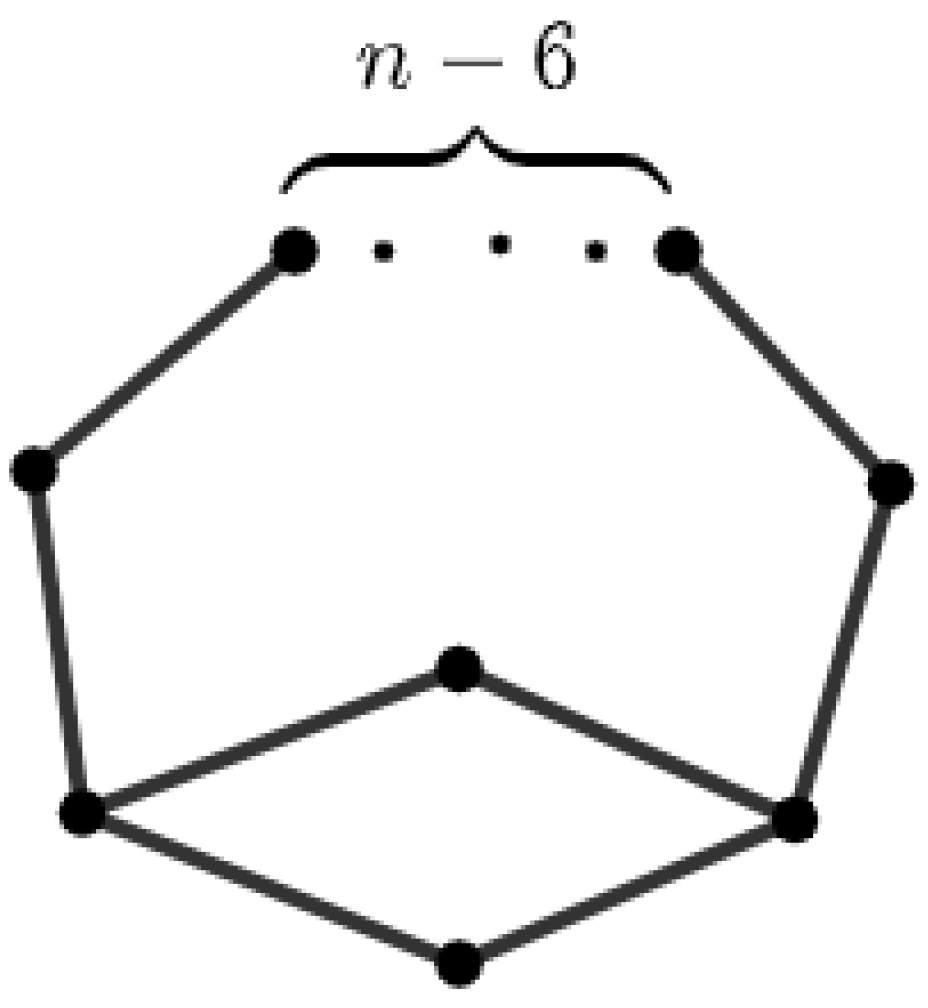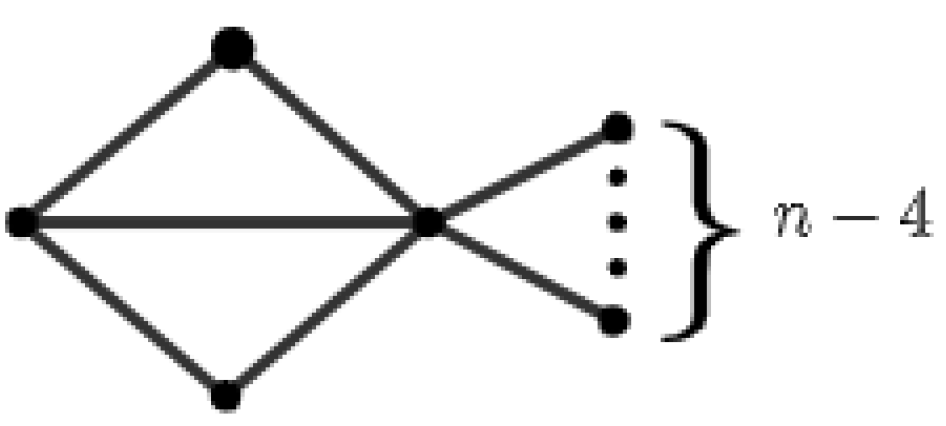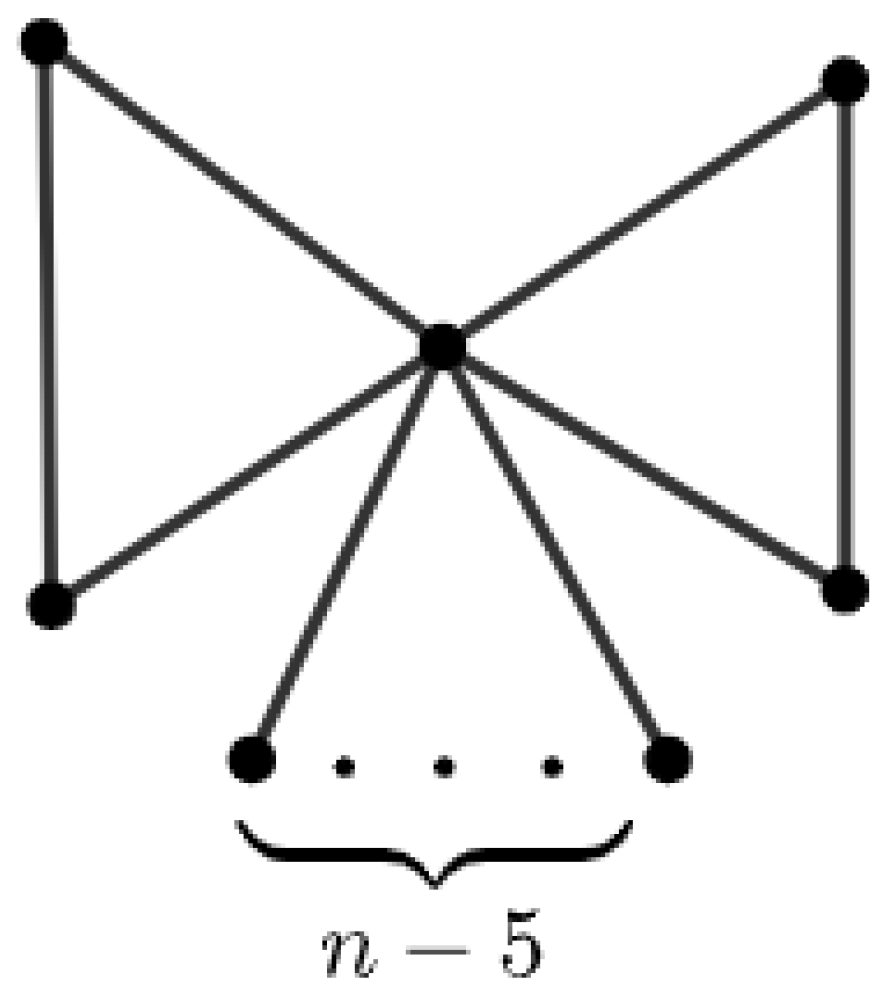On the Extremal Weighted Mostar Index of Bicyclic Graphs
Abstract
:1. Introduction
2. Preliminaries
- (1)
- If is even and , thenwhere and are the two components of .
- (2)
- If is odd and , thenwhere and are the two components of .
3. Proof of Theorem 1
4. Proof of Theorem 2
5. Conclusions and a Further Research Problem
Author Contributions
Funding
Data Availability Statement
Conflicts of Interest
References
- Bondy, J.A.; Murty, U.S.R. Graph Theory; Springer: Berlin, Germany, 2008. [Google Scholar]
- Došlić, T.; Martinjak, I.; Škrekovski, R.; Tipurić Spužević, S.; Zubac, I. Mostar index. J. Math. Chem. 2018, 56, 2995–3013. [Google Scholar] [CrossRef]
- Ali, A.; Došlić, T. Mostar index: Results and perspectives. Appl. Math. Comput. 2021, 404, 126–245. [Google Scholar] [CrossRef]
- Dehgardi, N.; Azari, M. More on Mostar index. Appl. Math. E-Notes. 2020, 20, 316–322. [Google Scholar]
- Deng, K.; Li, S. Extremal catacondensed benzenoids with respect to the Mostar index. J. Math. Chem. 2020, 58, 1437–1465. [Google Scholar] [CrossRef]
- Deng, K.; Li, S. On the Extremal Mostar Indices of Trees with a Given Segment Sequence. Bull. Malays. Math. Sci. Soc. 2022, 45, 593–612. [Google Scholar] [CrossRef]
- Ghorbani, M.; Rahmani, S.; Eslampoor, M. Some new results on Mostar index of graphs. Iran. J. Math. Chem. 2020, 11, 33–42. [Google Scholar]
- Hayat, F.; Zhou, B. On cacti with large Mostar index. Filomat 2019, 33, 4865–4873. [Google Scholar] [CrossRef]
- Hayat, F.; Zhou, B. On Mostar index of trees with parameters. Filomat 2019, 33, 6453–6458. [Google Scholar] [CrossRef]
- Huang, S.; Li, S.; Zhang, M. On the extremal Mostar indices of hexagonal chains. Match-Commun. Math. Comput. Chem. 2020, 84, 249–271. [Google Scholar]
- Liu, G.; Deng, K. The maximum Mostar indices of unicyclic graphs with given diameter. Appl. Math. Comput. 2023, 439, 127636. [Google Scholar] [CrossRef]
- Tepeh, A. Extremal bicyclic graphs with respect to Mostar index. Appl. Math. Comput. 2019, 355, 319–324. [Google Scholar] [CrossRef]
- Xiao, Q.; Zeng, M.; Tang, Z.; Hua, H.; Deng, H. The hexagonal chains with the first three maximal Mostar indices. Discrete Appl. Math. 2021, 288, 180–191. [Google Scholar] [CrossRef]
- Arockiaraj, M.; Clement, J.; Tratnik, N. Weighted Mostar indices as measures of molecular peripheral shapes with applications to graphene, graphyne and graphdiyne nanoribbons. SAR QSAR Environ. Res. 2020, 31, 187–208. [Google Scholar] [CrossRef] [PubMed]
- Kandan, P.; Subramanian, S.; Rajesh, P. Weighted Mostar indices of certain graphs. Adv. Math. 2021, 10, 3093–3111. [Google Scholar] [CrossRef]
- Asmat, F.; Asmat, H.; Askar, S. On weighted vertex and edge Mostar index for trees and cacti with fixed parameter. Eur. J. Pure Appl. Math. 2023, 16, 1794–1808. [Google Scholar] [CrossRef]
- Zhen, Q. Sum-weighted Mostar Index of Trees and Unicyclic Graphs. J. Lanzhou Jiaotong Univ. 2023, 42, 139–143. [Google Scholar]




Disclaimer/Publisher’s Note: The statements, opinions and data contained in all publications are solely those of the individual author(s) and contributor(s) and not of MDPI and/or the editor(s). MDPI and/or the editor(s) disclaim responsibility for any injury to people or property resulting from any ideas, methods, instructions or products referred to in the content. |
© 2024 by the authors. Licensee MDPI, Basel, Switzerland. This article is an open access article distributed under the terms and conditions of the Creative Commons Attribution (CC BY) license (https://creativecommons.org/licenses/by/4.0/).
Share and Cite
He, Y.; Liu, M. On the Extremal Weighted Mostar Index of Bicyclic Graphs. Axioms 2024, 13, 519. https://doi.org/10.3390/axioms13080519
He Y, Liu M. On the Extremal Weighted Mostar Index of Bicyclic Graphs. Axioms. 2024; 13(8):519. https://doi.org/10.3390/axioms13080519
Chicago/Turabian StyleHe, Yuwei, and Mengmeng Liu. 2024. "On the Extremal Weighted Mostar Index of Bicyclic Graphs" Axioms 13, no. 8: 519. https://doi.org/10.3390/axioms13080519




